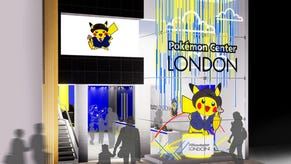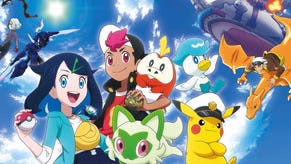Pokemon Scarlet & Violet hands-on: Lessons from Legends & Returning Traditions make this a fascinating, revolutionary new entry
Also details on how co-op is handled in this new open-world adventure.
Pokemon Scarlet & Violet are the follow-up to Sword and Shield, the first entry in a new generation. But in learning lessons from Legends Arceus, a fantastic new take on the series emerges.
A STUDY IN SCARLET
Pokemon Scarlet & Violet, the flagship games of a new Pokemon generation, find themselves in an interesting spot. A new Pokemon generation is always time for introspection, consideration, and gentle evolution - but earlier this year, a mere Pokemon spin-off tipped expectation of what the series can be upside down. The question that Scarlet & Violet face is easily asked, but challenging to answer: what does the next evolution of Pokemon look like, with all the tradition-disrupting ideas that Legends Arceus put forth taken into account?
That question is an interesting invitation for the Pokemon series to evolve, and Scarlet and Violet do appear to have a firm, full-throated answer. In how it cherry-picks ideas from Legends, from Sword and Shield, from series tradition and also yes, anew out of thin air, it’s arguably the most significant generational Pokemon reset in the history of the series. And that’s exciting.
In a 90-minute hands-on session, I got to play around in the world of Pokemon Scarlet - one of the two releases which will arrive next month, with a fairly traditional content split of Pokemon, legendaries, and even two different Poke Professor mentors. Time with Scarlet is equivalent to time with both games, though - and I left the hands-on impressed with the evolution of the series, which is less gentle and safe-feeling than I thought it’d be.

In some ways, what these new Pokemon titles are shooting for is mildly contradictory. Pokemon representatives there to guide us through the game casually referred to it as the “most streamlined” Pokemon game to date - but that doesn’t mean these games are simplified, nor easier. This is a full-fat Pokemon experience - but it’s got less hoops to jump through.
Basically, this game’s ‘streamlining’ mostly appears to mean removing barriers and simplifying the game flow - which plays into this title’s status as a true open world, where you can go anywhere and do whatever you want. Though the comparison is fairly tired, this makes it more like Breath of the Wild. Like that game, there’s no one thing you should go off and do – the choice is yours. Where past Pokemon games had a more linear structure - gyms sitting in that matrix like dungeons in Zelda - this game is more wide open. Go anywhere, do that. You see that mountain over there? You can… you get the idea.
Go with the Flow

After Arceus, this feels like a relatively natural evolution. At the same time, however, it’s important to underline just how different this game is. To use an admittedly ham-fisted comparison point, Arceus is more like Dragon Age Inquisition - an ‘open zone’ game, where you choose what zone you want to travel to and then have free exploration within that area. Scarlet and Violet are more like Skyrim, where all of its Spanish and Portuguese-inspired Poke-region is available to explore, free of load times or interruptions.
This all seems like a relatively unremarkable concept, but it’s only when you play the game that the strengths of both the concept and the execution become clear. Take Pokemon Centers, for instance - typically buildings, these are now more like open-air kiosks out in the world. Their functionality is the same, but there’s no walking through a door, no load screens - you just walk up, chat to the NPC behind the counter, right there, in the middle of the Overworld. I’m sorry to bring back this comparison - genuinely, I am - but in this game Pokecenters feel a lot like the stables in Breath of the Wild. Not quite towns, but open-air resting spots that also double as fast travel points. It just feels right.
One thing I love about the open world is how sound is used, too. That iconic Pokemon Center music is still present - but it’s diegetic music, presumably being piped through speakers of the stands out in the wild. As you near it, you’ll hear the music getting closer, and louder - almost comforting. Likewise, in town, I come across a busker - and as I approach the music crossfades into an acoustic guitar version of the town’s theme, matching the audio to his actions. There’s lots of touches like this, things that help the world to flow despite its entirely open-ended nature.
You can see where the focus is. Head into town and you’ll find a multitude of shops, their inventories split into multiple outlets - a place selling hats, another for shoes, one for socks and tights. But these aren’t physical stores you enter and explore - you enter the doorway and up pops a menu, from which you make your selection. This is streamlining, in a sense - the team clearly wanted to focus on building an expansive world rather than crafting small indoor spaces.
Or, indeed, the team wanted to focus on what matters - having lots of clothes options with lots of utility. No clothing or styles are gender-locked - so regardless of which trainer base type you pick at the start, you can wear whatever you like. You have the ability to take selfies both in single and multi-player, and gym leaders even take a selfie with you after their defeat - so your character’s look is important.
Whatever angle you look at it from, it’s more open than Pokemon has ever been before - even when compared to Legends Arceus.
Story Beats

In terms of how the game is structured, at the opening of my hands-on - which began with a save file that was a little way into the game - I had three core ‘storylines’ open to me. One of these, the ‘Titan’ path, involved investigating mysterious Pokemon - but chaperones warned me that though I could pursue this storyline, it was cutscene-heavy and would eat into my gameplay time - so I decided to explore the world and focus on the other two.
The first of these is Victory Road, and will be the most familiar to Pokemon fans - it’s the traditional Gym Leader challenge. As part of this, I trekked across the open world to a nearby town and tackled the only Gym in the area I was allowed to explore, which was grass-type. The Gym was one of the few discrete buildings that you could actually enter that I encountered. You walk inside, chat at a front desk, and as is Pokemon tradition get handed a Gym Leader challenge… but this one was outside the gym.
This is a clever change. Rather than some puzzle to solve in the Gym building, you’re given a challenge - in this instance, a little game of hide-and-seek with a Pokemon - out in the surrounding area of the open world. It showcases this game making the most of its wide open setting. When you’re done, you return to the gym to fight the leader in a battle format that is a lot lower-key than Sword and Shield but otherwise still quite familiar.
The third pillar, and the second I experienced, is the Rival Team path. This is also a series tradition - and this time out it’s Team Star in your sights. It appears that there are ‘Team Leaders’ for Team Star scattered around the world - and each appears to be the master of a specific Pokemon type. In my hands-on, I got to battle through the base of the fire-type boss - and then take on the boss themselves.
I won’t spoil the unique boss battle against the Team Leader - it’s very different to a gym - but what is interesting is the enemy base itself. The Pokemon battles prior to the boss aren’t traditional battles, but take place in the overworld, in real time. You send a Pokemon out, and it beats up nearby enemies, then returns. There’s no selecting moves, not even any healing. It’s a time trial, where I had to defeat 30 Pokemon inside the base, with only three of my Pokemon, to trigger the boss. This is interesting, but it felt a little cheap and unengaging, to be honest. And I was disappointed that when I tried to glide into the rear of the base to take the enemy by surprise, a UI prompt came up and literally told me to walk up to the front gate. This is an open world… most of the time.
A World Apart
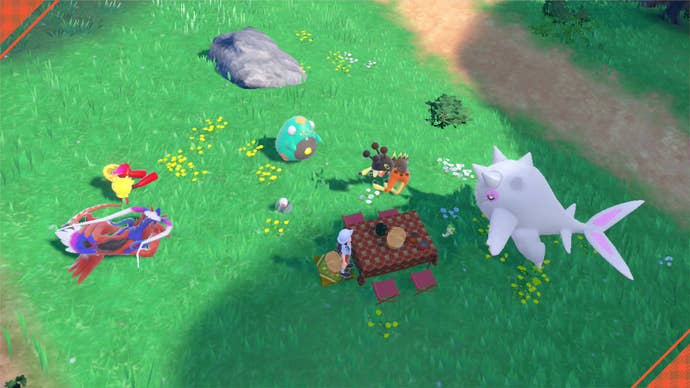
That most of the time is great, though. I admit I do miss the streamlined Pokemon catching and nature documentary sort of feel of tooling around and distracting Pokemon in Legends Arceus - but I still enjoyed seeing how more traditional Pokemon battles and catching slotted into this new open world.
Some changes are purely cosmetic, like how smaller Pokemon species roll around in groups until you trigger a battle, where you’ll then go one-on-one with a single example of the species. Others have a material gameplay effect, like how trainers no longer automatically engage you in combat on sight - you instead have to talk to them to initiate battles.
In multiplayer, features like raids and battling others are back, of course, but the biggest and most exciting new change is how co-op play works, which is just… Well, it’s more like a lot of co-operative open world games. You can invite other players into your world, and you can hang out. It’s pretty much that simple.
What you can do in the world is fairly limited - you can battle each other, for instance, but can’t team up to assist with story progression or trainer battles and the like - but what I enjoy about it is the sheer… hangoutitude of it all. Because Pokemon battles literally take place in the open world, your friends can stand off to the side as you battle, taking photos and emoting. You can compare fashion fits. Or you can explore together, working to find new nooks and crannies of the world. What you can do together is in truth quite limited, but despite that I like the co-op aspect a great deal. It’s just a nice vibe.
In fact, a nice vibe describes it fairly well. Even when you zoom the map out, and see a slew of icons corresponding to all the gyms, team leaders and other challenges that you can go find, it’s not overwhelming. You can see a great deal of care has been taken to make this an inviting and accessible open world - little things, like quest-givers and shops having yellow speech bubbles as you approach, or areas on the map being clearly numbered in a chronology that likely corresponds to their difficulty. Want to head to area 12 right from the start? Well, you can - but good luck.
Technical Machine
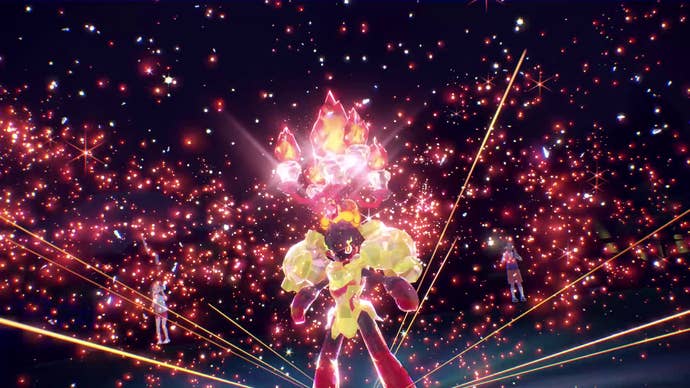
The world is also well-built. Probably the biggest compliment I can give is that when exploring Mesagoza, the largest city in the game, I found myself wishing I could ‘read’ Pokelanguage, and read what all the signs on the non-accessible buildings say. They probably say nothing of course - it’s likely gibberish - but this world inspires the thought that it might not be. There’s a power in that.
As seems to be Pokemon tradition, the biggest drawback was the performance. This is preview, and non-final code, but let’s be blunt: it runs like a bit of a Lechonk. That’s a new pig type Pokemon, by the way. I mean it runs like a bit of a pig. The world is expansive, and impressive, but both the performance and visuals are hard to fully understand, even on Switch - especially in the wake of a game like Xenoblade 3. I just don’t quite get it.
None of it is particularly egregious, and in truth the Pokemon and character models look better than ever before, the closest to the anime the games have come. But the frame-culling in things in the distance, the pop-in, the way the frame rate of the map chugs as you run and turn the camera at the same time - it does make one wince. Part of this is the Switch creaking with age, and the other half is just Game Freak struggling with the technology, which has been a bit of a theme over the years.
It’s not a deal-breaker, but it’s there. I do wish the game ran better - and hopefully it will by the time it lands next month.
All told, however, I’m just… pretty ecstatic about Pokemon Scarlet & Violet. What’s interesting is, in sitting down to write this preview, I realized I liked the game even more than I thought I did. As I played, I found myself comparing it to Legends Arceus quite often, and fairly often unfavorably. But, as my feelings about the game have time to settle, I realize that this is a very different type of game - and embracing that unlocked a better perspective on what this game is.
It’s a bold new vision for Pokemon, and while it stops short of being a full-blown reinvention, it’s got a lot of strong ideas and creativity going for it. I can’t wait to play the final version.
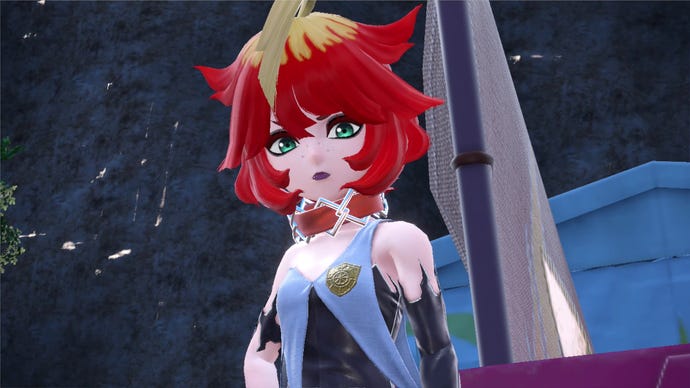

.jpg?width=291&height=164&fit=crop&quality=80&format=jpg&auto=webp)



